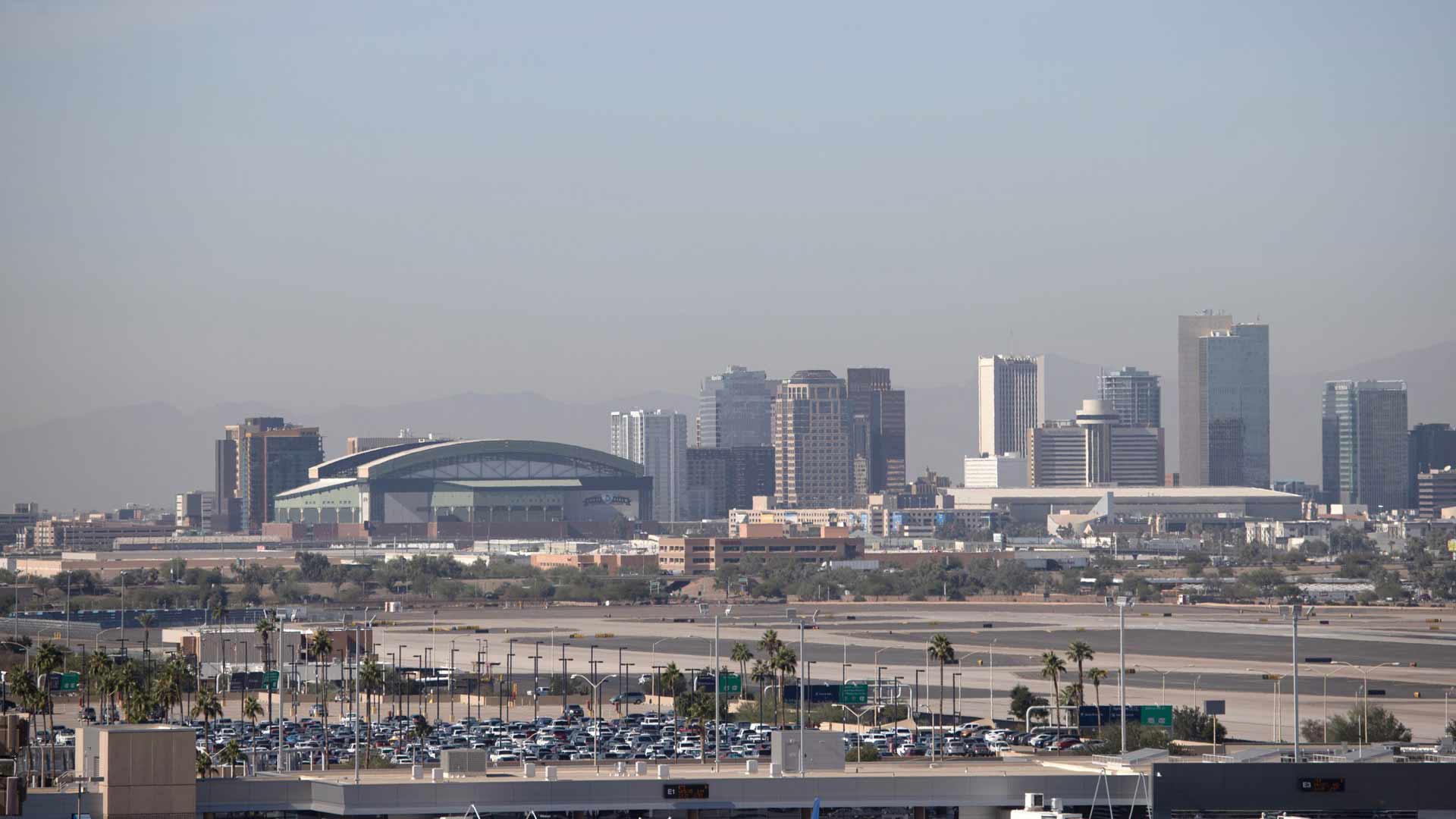 Phoenix officials are seeking public input on updates to the city’s Climate Action Plan, as the region grapples with human-caused climate change, including poor air quality, drought, and extreme heat.
Phoenix officials are seeking public input on updates to the city’s Climate Action Plan, as the region grapples with human-caused climate change, including poor air quality, drought, and extreme heat.
By David Brandt, Associated Press
Cam Ferguson gets to his spot on the street adjacent to Chase Field — home of Major League Baseball's Arizona Diamondbacks — about four hours before the first pitch to set up his usual display of cold water, sports drinks, peanuts, and candy.
By game time, it's about 103 degrees Fahrenheit (39.4 degrees Celsius) on this Labor Day afternoon in downtown Phoenix. Business is brisk.
“Two for five, but it's eight inside!” shouts another vendor, hawking water bottles. “Plus, they're having some problems with the air conditioning in there.”
It's always hot this time of year in central Arizona, but 2024 is proving to be an endless summer with especially high temperatures in Phoenix. On Tuesday, the city hit its 100th straight day with at least 100-degree temperatures. That's long since shattered the record of 76 days in a row set back in 1993, according to data from the National Weather Service.
“That is definitely an eye-catching number,” NWS meteorologist Sean Benedict said.
The temperature hit 102 F (38.9 C) in Phoenix on May 27 and has made it to triple digits every day since.
Benedict said that long streaks of desert heat usually are broken up by rain, but the monsoon hasn’t delivered much. The persistent heat also got an early start, with the triple-digit days already piling up in May.
It doesn't look like a break is coming any time soon.
Unseasonably high temperatures are expected this week across the western U.S., with an excessive heat warning forecast for Wednesday through Friday in Arizona cities including Phoenix and Lake Havasu City, as well as Las Vegas and other parts of Nevada, including Laughlin and Pahrump.
The California desert communities of Palm Springs, Twentynine Palms, Needles, and Barstow will also heat up, with highs of up to 118 F (47.7 C) in Death Valley’s Furnace Creek expected at week’s end.
Public health officials in Arizona’s Maricopa County — where Phoenix is located, the hottest metro area in the U.S. — say that as of Aug. 24, there had been 150 heat-related deaths confirmed so far this year, with another 443 under investigation. There were 645 heat-related deaths last year in the county of some 4.5 million people.
Pretty much any way the data is parsed, 2024 marks another record-breaking summer of heat in Phoenix. It’s been the hottest meteorological summer, which includes the months of June, July, and August. And it’s the same story throughout the western U.S. with several locations in California, Nevada, Arizona, Utah, and New Mexico setting records or coming close.
Across California, red flag warnings for increased wildfire risk were issued. A blaze that broke out Monday and was fed by erratic winds knocked out power and prompted evacuation orders for more than 500 residents of a remote forest community near Lake Tahoe. The Bear Fire about 20 miles (32 km) north of Truckee grew to more than 2 square miles (5 square km) by Tuesday morning, with zero containment.
Cooling centers were set up across Los Angeles County, where officials urged residents to check on neighbors who are elderly, unwell or otherwise vulnerable amid soaring temperatures. “Hot days aren’t just uncomfortable — they can be dangerous,” said LA County Health Officer Muntu Davis.
There’s no respite from the heat for outdoor vendors. It’s the same story for plenty of other people in the Phoenix area, particularly construction workers and landscapers.
Ferguson's job outside in downtown Phoenix is a hot one. The concrete and asphalt all over downtown makes it feel even hotter, with the heat radiating through the streets as more than 40,000 fans gather for a game between the Los Angeles Dodgers and Diamondbacks.
“Lots of SPF shirts and ice-cold water,” Ferguson said, about coping with the heat. “That’s the only way to get through it.”
Chase Field can be air-conditioned and has a retractable roof that is closed for most games during the middle of summer, which is obviously good for fans and players. But keeping the giant stadium cool in the summer is sometimes tricky, and players have occasionally commented about how surprisingly stuffy it gets inside.
Ramiro Lopez has been doing landscaping in suburban Phoenix for five years and says each summer feels hotter than the last. Between jobs, he takes breaks in his air-conditioned truck to stave off the heat, but the past three months have been a grind.
“I've learned to drink lots of sports drinks and make sure I'm done by 1 p.m.,” Lopez said. “Otherwise, it's just too much.”
In Phoenix, there have been 37 nights this summer that didn't cool off below 90 F ( 32.2 C), another record.
There have also been 54 days of 110-degree temperatures, which is just one day away from breaking the record of 55 days last year. That number could be broken later this week. The heat is tough for everyone but is particularly difficult for low-income areas.
“Not being able to cool off at night can affect people’s health because heat can accumulate in the body,” Arizona State University climatologist Erinanne Saffell wrote in an email response. “Folks should make sure to stay cool and hydrate.”
Associated Press reporters Anita Snow in Phoenix and Christopher Weber in Los Angeles contributed to this report.

By submitting your comments, you hereby give AZPM the right to post your comments and potentially use them in any other form of media operated by this institution.